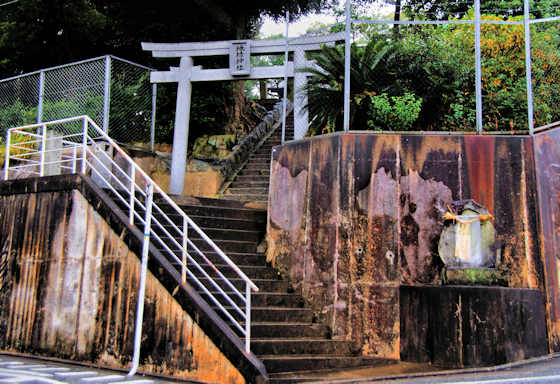Wednesday, February 12, 2014
Along The Way (Izumo version)
Monday, February 10, 2014
Along the Way
On the afternoon of Sunday, September 4th, 2011, the eighth day of my Shikoku Pilgrimage, I walked the main road west from Temple 21, Tairyuji, towards Temple 22, Byodoji. Early that morning I had left the mountains where I had been trapped by Typoon Talas for a couple of days, took the ropeway up to and down from Tairyuji, and passed through the village of Naka. There were no major sights along the road, but the usual succession of small hokora, roadside shrines, like this one that was guarded by Okinawan style shishi
I climbed up to a largish Hachiman Shrine that, like so many shrines, gave the appearance of being abandoned. I was rewarded by a pair of unusal komainu, something I am always on the look out for. Coming back down to the main road a tiny old lady came out of the door of her house and insisted I sit awhile and drink some cold green tea she offered me.The kindness of strangers. I am not particularly fond of green tea, but it is impolite to refuse Osettai.
You can't walk far in Japan without passing a Jizo, and I must admit I pass many of them by, but a statue of Fudo Myo O, my favorite Buddhist deity, almost always call for a prayer and a photo.
Cresting the pass, the view is, for me anyway, what I would describe as typical Japan.
And then some more small shrines with diverse komainu before encountering what was to be the days most pleasant surprise just before reaching Byodoji.....
Labels:
Fudo Myojin,
henro,
komainu,
tokushima
Saturday, February 8, 2014
Izumo 33 Kannon Pilgrimage Temple 10 Zenjoji
Thursday, February 6, 2014
Chiroku Shrine
Chiroku Shrine
Labels:
haniyasuhime,
izanagi,
komainu,
kyushu108,
Shrine,
takehaniyasuhiko
Tuesday, February 4, 2014
Mitoya Tenmangu
Sunday, February 2, 2014
Shokasonjuku Academy
The Shokasonjuku is located in the grounds of the Shoin Shrine in Hagi, Yamaguchi, and is where Yoshida Shoin taught many of the future leaders of Meiji Japan.
It was originally just a single-roomed structure but was expanded due to the large number of students who wanted to attend. It was also his home as at the time he was under house arrest for his attempt to stow away on an American ship.
Shoin taught here for just one year before he was rearrested and the school forced to close.
His students included Ito Hirobumi, the first Prime Minister of Japan, Yamagata Aritomo, Japan's third Prime Minister, Kido Takayoshi, a senior statesman and another of the architects of the new Meiji state, Inoue Kaoru, another major politician and statesman of Meiji Japan.
Labels:
hagi,
yamaguchi,
yoshida shoin
Thursday, January 30, 2014
Izumo 33 Kannon Pilgrimage Temple 9 Mine-ji
I have been to Mineji before and found it to be really interesting. Details about the temple and its history can be found in this post, and a post about the Nio and Fudo Myoo can be found here. One thing that was new this time was that the roof of the Niomon was covered in solar panels.
Though I already had plenty of photos it was a different day with different lighting conditions and I had a different camera, so I wandered around taking more photos.
Its only 180 meters above sea level, but still has nice views down to the valley and town below.
I hadn't noticed the garden before...... I went to the little office to chat with the priests, a father and son, and learnt that there was something else new.... a small tsuyado, a room offered for free for pilgrims to stay in. The son had walked the Shikoku pilgrimage and had obviously stayed in the many tsuyados there. This is the only one I know about on the Izumo 33 pilgrimage. They offered me the use of it for the night, and though there were still several more hours of daylight and my plan had been to sleep out a bit further upriver, I accepted.
The next morning as I was leaving the son came up and gave me some onigiri and fruit to have for breakfast. I like Mine-ji :)
Monday, January 27, 2014
Manhole Horses
There is archeological evidence that horses have been in Japan for thousands of years, however the earliest records of Japan by the Chinese in the third century say that Japan did not have any horses. It is known that horses were introduced from Korea in the 4-5th centuries and this seems to be from when most Japanese horses are descended. The above manhole is from Mochizuki, a small town in Nagano. The area bred and raised horses for the Imperial court since ancient times.
Kushima, at the southern tip of Miyazaki, is home to a breed of wild pony, the Misaki Pony, considered a Japanese breed. They live on Cape Toi and are a tourist attraction. there are about 100 of them. Misaki means "cape".
This final one is from Ishigaki Island in Okinawa, and other than the fact that the area offers horse riding as an attraction I can find no explanation for the horse on their manhole design.
Saturday, January 25, 2014
Izumo 33 Kannon Pilgrimage Temple 8 Hasedera
Thursday, January 23, 2014
Hiroshima Museum of Contemporary Art
The Hiroshima Museum of Contemporary Art was opened in 1989 on top of Hijiyama overlooking the city.
The most noticeable feature is the circular structure at the main entrance.
The gap in the circle is oriented towards the location of the nuclear bomb epicenter.
It was designed by Kisho Kurokawa who designed many museums in Japan and is considered one of the founders of the Metabolism Movement, a contemporary style of Japanese architecture.
It is a very large structure, but most of it is below ground.
The style of the buildings reflects that of traditional Japanese storehouses.
Labels:
Architecture,
hiroshima,
kisho kurokawa,
Museum
Subscribe to:
Posts (Atom)










































